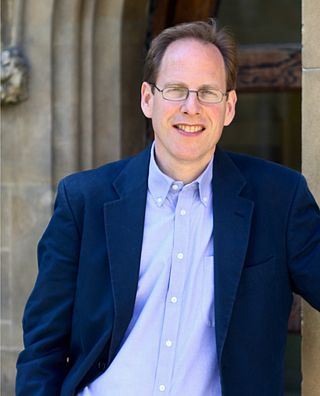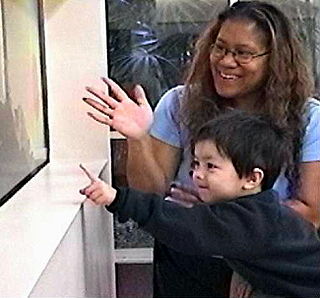Related Research Articles

Asperger syndrome (AS), also known as Asperger's syndrome, formerly described a neurodevelopmental disorder characterized by significant difficulties in social interaction and nonverbal communication, along with restricted and repetitive patterns of behavior, interests, and activities. The syndrome has been merged with other disorders into autism spectrum disorder (ASD) and is no longer considered a stand-alone diagnosis. It was considered milder than other diagnoses that were merged into ASD by relatively unimpaired spoken language and intelligence.
Facilitated communication (FC), or supported typing, is a scientifically discredited technique that claims to allow non-verbal people, such as those with autism, to communicate. The technique involves a facilitator guiding the disabled person's arm or hand in an attempt to help them type on a keyboard or other such device which they are unable to properly use if unfacilitated.

Diagnoses of autism have become more frequent since the 1980s, which has led to various controversies about both the cause of autism and the nature of the diagnoses themselves. Whether autism has mainly a genetic or developmental cause, and the degree of coincidence between autism and intellectual disability, are all matters of current scientific controversy as well as inquiry. There is also more sociopolitical debate as to whether autism should be considered a disability on its own.

Sir Simon Philip Baron-Cohen is a British clinical psychologist and professor of developmental psychopathology at the University of Cambridge. He is the director of the university's Autism Research Centre and a Fellow of Trinity College.

Neurodiversity is a framework for understanding human brain function and mental illness. It argues that diversity in human cognition is normal and that some conditions classified as mental disorders are differences and disabilities that are not necessarily pathological.
Ole Ivar Løvaas was a Norwegian-American clinical psychologist and professor at the University of California, Los Angeles. He is most well known for his research on what is now called applied behavior analysis (ABA) to teach autistic children through prompts, modeling, and positive reinforcement. The therapy is also noted for its use of aversives (punishment) to reduce undesired behavior, however these are now used less commonly than in the past.
Discrete trial training (DTT) is a technique used by practitioners of applied behavior analysis (ABA) that was developed by Ivar Lovaas at the University of California, Los Angeles (UCLA). DTT uses mass instruction and reinforcers that create clear contingencies to shape new skills. Often employed as an early intensive behavioral intervention (EIBI) for up to 25–40 hours per week for children with autism, the technique relies on the use of prompts, modeling, and positive reinforcement strategies to facilitate the child's learning. It previously used aversives to punish unwanted behaviors. DTT has also been referred to as the "Lovaas/UCLA model", "rapid motor imitation antecedent", "listener responding", errorless learning", and "mass trials".
High-functioning autism (HFA) was historically an autism classification where a person exhibits no intellectual disability, but may experience difficulty in communication, emotion recognition, expression, and social interaction.
Mind-blindness, mindblindness or mind blindness is a theory initially proposed in 1990 that claims that all autistic people have a lack or developmental delay of theory of mind (ToM), meaning they are unable to attribute mental states to others. According to the theory, a lack of ToM is considered equivalent to a lack of both cognitive and affective empathy. In the context of the theory, mind-blindness implies being unable to predict behavior and attribute mental states including beliefs, desires, emotions, or intentions of other people. The mind-blindness theory asserts that children who delay in this development will often develop autism.

Autism therapies include a wide variety of therapies that help people with autism, or their families. Such methods of therapy seek to aid autistic people in dealing with difficulties and increase their functional independence.
Pivotal response treatment (PRT), also referred to as pivotal response training, is a naturalistic form of applied behavior analysis used as an early intervention for children with autism that was pioneered by Robert Koegel and Lynn Kern Koegel. PRT advocates contend that behavior hinges on "pivotal" behavioral skills—motivation and the ability to respond to multiple cues—and that development of these skills will result in collateral behavioral improvements. In 2005, Richard Simpson of the University of Kansas identified pivotal response treatment as one of the four scientifically based treatments for autism.

Classic autism, also known as childhood autism, autistic disorder, (early) infantile autism, infantile psychosis, Kanner's autism,Kanner's syndrome, or (formerly) just autism, is a neurodevelopmental condition first described by Leo Kanner in 1943. It is characterized by atypical and impaired development in social interaction and communication as well as restricted, repetitive behaviors, activities, and interests. These symptoms first appear in early childhood and persist throughout life.

Autism, formally called autism spectrum disorder (ASD) or autism spectrum condition (ASC), is a neurodevelopmental disorder marked by deficits in reciprocal social communication and the presence of restricted and repetitive patterns of behavior. Other common signs include difficulty with social interaction, verbal and nonverbal communication, along with perseverative interests, stereotypic body movements, rigid routines, and hyper- or hyporeactivity to sensory input. Autism is clinically regarded as a spectrum disorder, meaning that it can manifest very differently in each person. For example, some are nonspeaking, while others have proficient spoken language. Because of this, there is wide variation in the support needs of people across the autism spectrum.
This relationship between autism and memory, specifically memory functions in relation to Autism Spectrum Disorder (ASD), has been an ongoing topic of research. ASD is a neurodevelopmental disorder characterised by social communication and interaction impairments, along with restricted and repetitive patterns of behavior. In this article, the word autism is used to refer to the whole range of conditions on the autism spectrum, which are not uncommon.
The history of autism spans over a century; autism has been subject to varying treatments, being pathologized or being viewed as a beneficial part of human neurodiversity. The understanding of autism has been shaped by cultural, scientific, and societal factors, and its perception and treatment change over time as scientific understanding of autism develops.
Discrimination against autistic people is the discrimination, persecution, and oppression that autistic people have been subjected to. Discrimination against autistic people is a form of ableism.
The rapid prompting method (RPM) is a pseudoscientific technique that attempts to aid communication by people with autism or other disabilities to communicate through pointing, typing, or writing. Also known as Spelling to Communicate, it is closely related to the scientifically discredited technique facilitated communication (FC). Practitioners of RPM have failed to assess the issue of message agency using simple and direct scientific methodologies, saying that doing so would be stigmatizing and that allowing scientific criticisms of the technique robs people with autism of their right to communicate. The American Speech-Language-Hearing Association has issued a statement opposing the practice of RPM.
Stuart Vyse is an American psychologist, teacher, speaker and author who specializes in belief in superstitions and critical thinking. He is frequently invited as a speaker and interviewed by the media as an expert on superstitious behavior. His book Believing in Magic: The Psychology of Superstition won the American Psychological Association's William James Book Award.
Social (pragmatic) communication disorder (SPCD), also known as pragmatic language impairment (PLI), is a neurodevelopmental disorder characterized by significant difficulties in the social use of verbal and nonverbal communication. Individuals with SPCD struggle to effectively engage in social interactions, interpret social cues, and use language appropriately in social contexts. This disorder can have a profound impact on an individual's ability to establish and maintain relationships, navigate social situations, and participate in academic and professional settings. Although SPCD shares similarities with other communication disorders, such as autism spectrum disorder (ASD), it is recognized as a distinct diagnostic category with its own set of diagnostic criteria and features.

The theory of the double empathy problem is a psychological and sociological theory first coined in 2012 by Damian Milton, an autistic autism researcher. This theory proposes that many of the difficulties autistic individuals face when socializing with non-autistic individuals are due, in part, to a lack of mutual understanding between the two groups, meaning that most autistic people struggle to understand and empathize with non-autistic people, whereas most non-autistic people also struggle to understand and empathize with autistic people. This lack of understanding may stem from bidirectional differences in communication style, social-cognitive characteristics, and experiences between autistic and non-autistic individuals, but not necessarily an inherent deficiency. Recent studies have shown that most autistic individuals are able to socialize, communicate effectively, empathize well, and display social reciprocity with most other autistic individuals. This theory and subsequent findings challenge the commonly held belief that the social skills of autistic individuals are inherently impaired, as well as the theory of "mind-blindness" proposed by prominent autism researcher Simon Baron-Cohen in the mid-1980s, which suggested that empathy and theory of mind are universally impaired in autistic individuals.
References
- 1 2 3 Rosa, Shannon Des Roches (2022-03-15). "Believing in Nonspeakers and Communication Rights". THINKING PERSON'S GUIDE TO AUTISM. Retrieved 2023-10-16.
- 1 2 3 4 5 "New Course Connects Students With Autistic 'Tribe'". UVA Today. 2016-11-07. Retrieved 2023-09-20.
- 1 2 3 "ORCID". orcid.org. Retrieved 2023-11-20.
- ↑ Jaswal, Vikram K.; Markman, Ellen M. (2003). "The relative strengths of indirect and direct word learning". Developmental Psychology. 39 (4): 745–760. doi:10.1037/0012-1649.39.4.745. PMID 12859127.[ non-primary source needed ]
- ↑ Jaswal, Vikram Kenneth (2003). A developmental study of the division of linguistic labor (Thesis). ProQuest 305293012.[ non-primary source needed ]
- ↑ Jaswal, Vikram K. (December 2004). "Don't Believe Everything You Hear: Preschoolers' Sensitivity to Speaker Intent in Category Induction". Child Development. 75 (6): 1871–1885. doi:10.1111/j.1467-8624.2004.00822.x. PMID 15566385.[ non-primary source needed ]
- 1 2 "Prof explains why sad children learn better". C-VILLE Weekly. Retrieved 2023-10-16.
- ↑ Strauss, Valerie (2021-11-30). "Parents: Why our second-grader is not going back to school". Washington Post. ISSN 0190-8286 . Retrieved 2023-10-16.
- ↑ "Debate unfurls over inclusivity and authenticity in research involving minimally verbal autistic people". Spectrum | Autism Research News. 2023-09-25. Retrieved 2023-10-16.
- ↑ Vyse, Stuart (May 20, 2020). "Of Eye Movements and Autism: The Latest Chapter in a Continuing Controversy". skepticalinquirer.org. Skeptical Inquirer. Archived from the original on 29 November 2023. Retrieved 29 November 2023.
- ↑ Beals, Katharine (2 January 2021). "A recent eye-tracking study fails to reveal agency in assisted autistic communication". Evidence-Based Communication Assessment and Intervention. 15 (1): 46–51. doi:10.1080/17489539.2021.1918890. S2CID 236600771.
- ↑ Jaswal, Vikram K.; Akhtar, Nameera (2019). "Supporting autistic flourishing". Behavioral and Brain Sciences. 42. doi:10.1017/s0140525x19000025.[ non-primary source needed ]
- 1 2 Jaswal, Vikram K.; Akhtar, Nameera (2018-07-13). "Opinion | How to Meet Autistic People Halfway". The New York Times. ISSN 0362-4331 . Retrieved 2023-10-16.[ non-primary source needed ]
- ↑ McNulty, Jennifer. "Scholars weigh in on new ideas about autism". UC Santa Cruz News. Retrieved 2023-10-16.
- ↑ Akhtar, Nameera; Jaswal, Vikram K. (2013). "Deficit or difference? Interpreting diverse developmental paths: An introduction to the special section". Developmental Psychology. 49 (1): 1–3. doi:10.1037/a0029851. PMID 23316772.[ non-primary source needed ]
- ↑ "What Is Neurodiversity?". Child Mind Institute. Retrieved 2023-11-27.